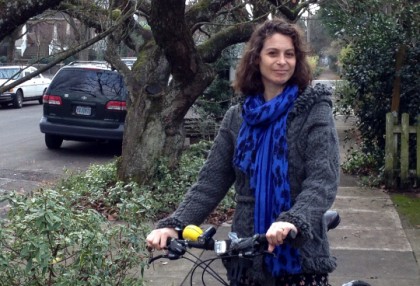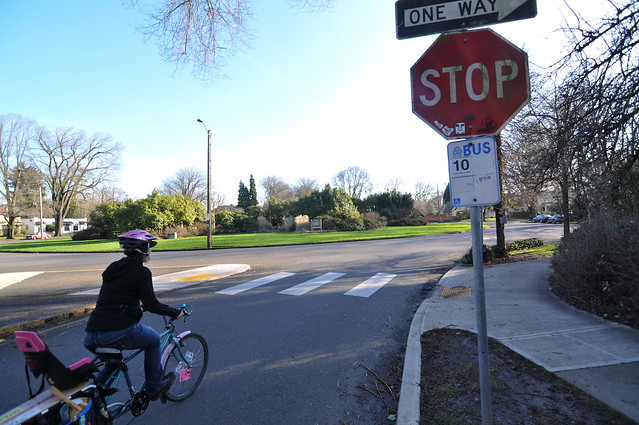My friend, a recent transplant from the Midwest, was describing his 35-mile round trip bike commute during the misty quiet of the early mornings. He sets off in the dark, living his ideals, even on those days when he doesn’t really want to. His commitment put me in awe.
But what he wanted to talk about was stop signs.
“What do people here in Portland do?” he asked, eager to know. “At 4 a.m., when no one is around, do you stop?”
At first, I thought he was joking. Is there any place in the U.S. where people stop their bikes at stop signs at 4 in the morning when no one is around?
But he seemed earnest. Because I am a Portland native and a 20+ year bike commuter, he must have thought I have some insider track. But as I considered his question, I realized that I am but one single biker with my own opinions of right and wrong. Had he asked my 14-year-old daughter, an avid rule-follower, he would have gotten a completely different response.
I know what I do, but what is the official Portland “culture” when it comes to stop signs?
The only way to find out was to dust off my trusty pad of write-in-the-rain paper, don some wool socks, and observe the natives.
An informal traffic study
The Portland police often choose Ladd Circle in SE Portland to set up large-scale infraction crackdowns aimed at bicycle riders – I narrowly escaped a ticket myself last year.
I set up shop early one sunny afternoon, leaning my bike against a concrete utility housing and hopping up on top. I sat cross-legged in my yellow bike slicker, facing SE Ladd as people rode towards me from downtown on their way home for the evening.
“Despite the overwhelming number of tallies in the “no stop” column, I did not witness a single dangerous traffic interaction.”
I tracked all vehicles as they approached the intersection of Ladd with the Circle, where a familiar red octagonal sign stood, clearly telling them that traffic law required them to stop. There was no ambiguity here, but what I witnessed surprised me. In the one hour I sat there, less than half of all vehicles actually stopped, and by “stop” I mean wheels stopped turning. Thirty-six percent of cars and 71 percent of bikes failed to stop, which averaged 60 percent non-compliance among all vehicle types. The difference between the behavior of people when they sat behind a steering wheel and when they sat atop a bicycle seat was significant: 34 percent more people disobeyed the law when they rode their bikes.
As I sat there, easily identifiable as a biker by my attire, obviously taking notes, I got a variety of responses. Many riders tried to behave lawfully. They put down a foot to imply “halt of forward progress,” even as they continued to roll, or they squeezed on the brakes all of a sudden when they saw that I was tallying up their actions. A few sneered and made unkind remarks from afar as if my presence was some sort of alliance with Big Brother.
I could have tut-tutted the high rate of disobedience as I watched, but all along, I knew that my own traffic behavior was no different from those I observed, both on two wheels and on four. I feel no guilt for my own infractions, nor do I judge any of the vehicle owners harshly, because, despite the overwhelming number of tallies in the “no stop” column, I did not witness a single dangerous traffic interaction.
In fact, traffic never slowed and not a single driver or biker seemed uncertain about what those around them were doing. The lack of a full, complete stop didn’t have much effect on the success of the intersection.
Advertisement
Indeed, the traffic circle configuration itself is a serious tease. Traffic circles are meant to speed traffic along without forcing a stop or the “look left-look right-look left” that is required at four-way intersections. In Bend, the traffic circle is meant to be entered and exited without stopping.
My data collection point, I decided, was not the typical intersection on which I could base conclusions about Portland bikers in general. As I wrapped up an hour of data collection, I knew that further study was required.
Clinton Street: The plot thickens
I found two additional observation points along the same bike corridor. One has a flashing red stop light on a four-way intersection with decent bike traffic and relatively low cross-traffic. It is situated on SE 34th and Clinton. The other data collection spot is a relatively high cross-traffic, four-way stop at SE 26th and Clinton. I selected 15-minute increments at each site during the morning and afternoon rush hours. In all, I tallied up 16 sessions of 15 minutes each, a total of 240 minutes.
I tracked 2,517 vehicles; 1,523 cars and 994 bikes. There was also one skateboarder, but I didn’t count him (he didn’t stop). The busiest intersection was 26th and Clinton, with 1,474 vehicles, followed by Ladd Circle, with 701. The intersection at 34th and Clinton had 342 vehicles.
The statistics varied by time of day and by intersection type. The most extreme sample was on a slow morning at Ladd Circle, during which 92 percent of all people failed to stop — 95 percent of bike riders, 83 percent of auto users. Of the people who did stop, it appeared that they did so only because there was someone in or near the crosswalk. Driving behavior and biking behavior was more similar in this sample than in any other. Apparently, no one thinks it is important to obey the stop sign in the morning when there is very low traffic, regardless of what conveyance is used. From my observations of the sparse, one-directional commuting traffic at that hour, it made perfect sense to me too.
My overall observations, including all time periods and locations, revealed that 51 percent of all people failed to stop: 38 percent of auto users and 71 percent of bikers. (The only road user type with a perfect stop score: TriMet bus operators.) Now I can answer my out-of-town friend. Less than half of Portlanders stop, whether in a car or on a bike. On average, bike riders glided through the stop signs 33 percent more than auto users did, and they surpassed drivers in this measurement for every time period observed.
A stop, or not a stop?
I used the legal “complete stop” threshold for determining whether behavior qualified as stopping or not. As I tallied up hundreds of commuters, this standard revealed itself as less and less useful when comparing cars and bikes. Because of their slower overall speed, bike riders have just as long, if not longer, to approach an intersection, observe the participants and determine whose turn comes next. For the most part, they slow down sooner and move slowly for longer as they evaluate the timing and safety of crossing. Rarely does this require a complete stop. When a bike rider does make a complete stop, it takes longer for her to get started again than it does for someone driving a car.
“When a car driver approaches a stop sign and rolls through without actually coming to a complete stop, it looks more like a stop than when a person does exactly the same thing on a bike. I wondered if police officers are able to overcome this optical bias.”
As drivers, we approach intersections faster, decelerate later and faster, and spend less time gathering data about the likely traffic pattern. We are also able to accelerate quicker when we start up again.
Because of these dramatic differences in auto travel speed, acceleration and deceleration, when a car driver approaches a stop sign and rolls through without actually coming to a complete stop, it looks more like a stop than when a person does exactly the same thing on a bike. I wondered if police officers are able to overcome this optical bias.
In the end, it doesn’t seem like traffic participants (as opposed to traffic cops) care much about stopping perfection. The rolling stop frequently satisfies all concerned. Even during the heaviest traffic period observed, there were no accidents, no near misses, not even that “you go – no, you go – no, you go” behavior that sometimes results from ambiguity among those who share the road. Experienced Portlanders, whether behind the wheel or on the saddle, probably agree that not stopping can often be the most courteous thing to do at intersections. If done safely, it allows the next intersection participant to make their move sooner. “California stoppers” in cars and on bikes tended to treat the other vehicles as respectfully as traditional stoppers, and, I like to think, made the entire interaction more efficient.
One last note: I did not have a special tally mark for people who zoomed through the intersection without waiting their turn. Had I, there would have been only 10 hash marks — and all of them would have represented people on bikes.
— Read Cathy’s past columns here.






